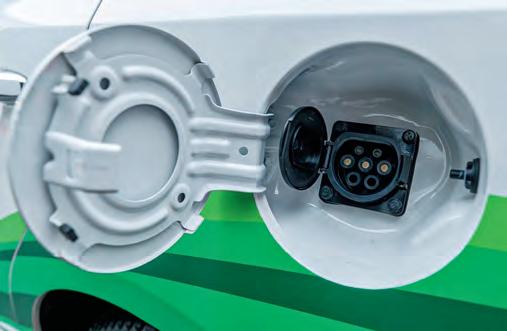
12 minute read
Strong character is good for the cause
Machine-building is a strong feature of the Belarusian economy. Tens of thousands of tractors, trucks, thousands of combines and buses, as well as passenger transport and electric transport are produced annually. Most of it is exported. In an externally oriented economy, the industry remains a reliable basis of the national budget, bringing billions of dollars in revenue to the country and providing thousands of Belarusians with well-paid jobs. The following article is about the development of this trend.
BBELGEE is perhaps the youngest brand in the country’s ma‑ the domestic workload. This will ensure a high level of performance chine-building industry. To get on to the wheels and to gain full and, as a result, develop the same cooperation network that has al‑ speed for several years became possible due to the principle of ready been established for trucks, tractors and road equipment. cooperation which is now applied by many world manufacturers. One workplace at BELGEE, for example, can provide 7 more The main partner and supplier of components for the domestic en‑ workplaces at related industries, service and support. terprise is China, which, in turn, uses the technology of the Swed‑ The situation in the machine-building industry should be ish firm Volvo. And then, as they say, everything is in our hands. radically corrected, said Alexander Lukashenko at a meeting on For two years of serial production of cars the level of localization the strategy of the industry development in November 2016. Ma‑ exceeded 50 percent. And this is a vivid example of caring for one’s chine -building has always been in the focus of attention of the own future, says Gennady Svidersky, director of the joint venture government, but it got under special control when five years ago it BELGEE: considerably subsided due to the fall of the world market, And it — B orisov has an engine plant, where complete assembly is must be said that the state managed to preserve this sector of in‑ made. The BELAZ-SERVICE enterprise produces rear and front dustry, despite the difficult transition phase. But we must move on. axles. There is a factory of radiators, a factory of seats. In other By the way, at the Minsk Automobile Plant among more than words, the full cycle of the plant iscomplemented by the supply half a thousand models, today there are new types of Euro‑5 and of the main components from the Belarusian enterprises. If today Euro‑6 standards not only for the Western European market, but we make a car on a full technological cycle, i. e . produce welding, also for the neighboring countries. The bulk of designers are work‑ painting, testing, assembly, plastic and metal parts, all these plants ing on expanding the model range, one of the priorities is on the have a large reserve for localization. development of a new family of buses. Testbed vehicles are already The development of our own production in the field of passenger ready, for example, model 303 and the electric bus on its basis. As car industry is a question of the future of the company. First of all, the the engineers themselves say, it is absolutely useless to copy some‑ fulfillment of localization conditions is the possibility of duty-free one, for specific markets we are developing target vehicles that are sales in the EAEU markets. Today, the task has been set to develop competitive in their technical characteristics.
Advertisement
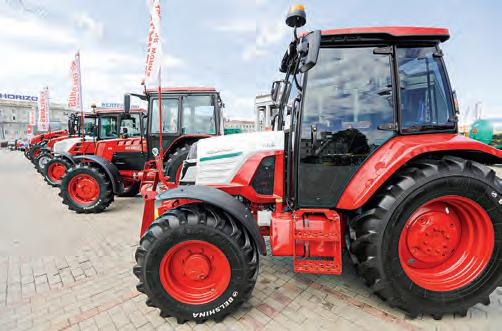
One workplace at BELGEE, for example, can provide 7 more workplaces at related industries, service and support
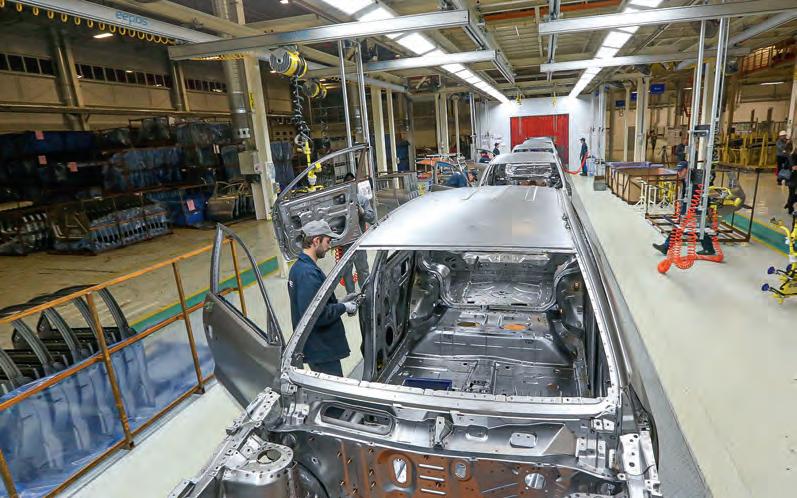

New urban transport will replace the country’s existing fleet of vehicles within 5 years.
Mechanical engineering, which gained power in Belarus back in the 1970s, remains the most important branch of the country today. Its agricultural and transport sectors are develop‑ ing particularly actively. The Minsk Tractor Plant has been one of t he best-in-class companies. In many respects, the enterprise is considered conservative. It is not surprising, as the classic Be‑ larus‑80 tractor is still popular on some world markets. But to g et stuck on the successes of the last century would be tactically wrong. MTZ has worked out a development strategy until 2030, directed at the improvement of the consumer properties and quality of new products in the context of tightening environmen ‑ tal requirements. Head of Design Bureau of the plant Sergey Ily‑ ukevich explains: — Much attention is paid to localization. For example, in 2018 we started the development of a snow compaction ma‑ chine — ratracs, which had not been produced in Belarus before. Initially, the level of localization of this vehicle was not more than 40%, while today — about 75%.
Yes, one should live and work with one’s own mind and skill. This conclusion was made at the enterprise many decades ago. MTZ is one of the ten world manufacturers of its segment, about 90 percent of tractors are exported. And this is a real achievement of 22 thousand employees of the holding. Though, competition in this field is tough. The only task is quality. We can say that this is the main issue for our machine -building industry.
Along with the cargo engineering, specialists consider special equipment production to be one of the promising areas. At pre‑ sent, the Amkodor includes about 120 units — both attachable equipment and equipment for various purposes. And in half of them domestically produced components constitute 90 percent. Dmitry Shapel, head of the assembly shop at the Udarnik plant of Amkodor Holding, notes: — For us, manufacturers, localization is important because at any moment we can eliminate certain design defects that for‑ eign suppliers may not know about. And we don’t have to spend currency on purchasing components abroad, but we support our economy, create jobs and constantly improve ourselves.
Belarus is an export -o riented state with a socially oriented model of market economy. More than half of industrial output is exported. It is no secret that this is typical of the countries with a high degree of development and openness of economy. Machinebuilding is perhaps the most knowledge-intensive sphere and one of the most capital-intensive. Every year, tens, if not hundreds, of millions of dollars are injected into it. But the pay-off must be com‑ mensurate. For example, such as a new MAZ tourist bus.
Last year, the plant BELGEE produced 20 thousand cars, and even in the Belarusian segment the sales figures rose — from 10 to 17 percent. The company is sure that if people vote with their wal‑ lets, and the products are sold abroad, it is a bright indicator of suc‑ cess and correctly chosen strategy. However, taking into account the fact that even the neighboring countries introduce their own localization requirements and tighten market protection meas‑ ures, Belarusian producers should not lose flexibility in building their marketing strategy. And have a firm character. By Vladimir Velikhov
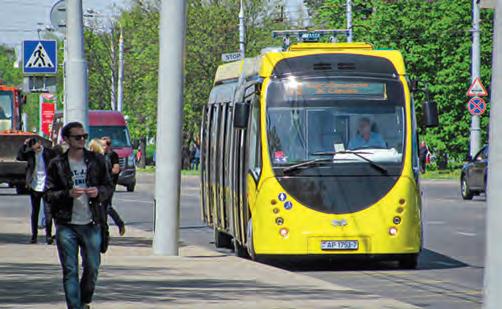
y b iny. v na
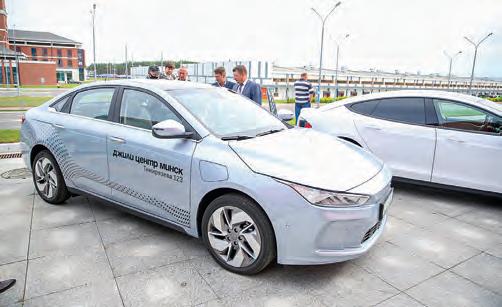
Moving along the pa th of environmental friendliness
The so-called “green cars” on the roads have already be‑ come our reality. They don’t need fuel — they just need charging from a normal sock‑ et. The design is extremely simple: electric motor, battery, four wheels. But the most important advantage is no emissions into the atmosphere.
Six years ago, there were only three elec‑ tric fuel stations in Belarus. One in Minsk, two in Gomel. It took up to eight hours to recharge the car. The method is reliable, but not always convenient: it limited the mobil‑ ity of owners of electric cars. In 2015, the charging time was reduced to half an hour. However, not everyone could recharge — the advantage was felt by the motorists, who were heading along the highway Minsk — Vilnius for the Baltic states, one of the most “electro -mobile” parts of Europe at that time. The year 2018 was a turning point, when a national operator was determined and a course for further expansion of facili‑ ties for electric cars was outlined. The logic of those innovations was quite simple: with the developed infrastructure, Belarusians will have more desire to buy electric cars. Today the main network of Belorusneft fill‑ ing stations has 267 charging stations. And there will be more! By 2022 there are plans to increase the scale and capacity of service so that to serve not 9 thousand but 35 thou‑
According to the estimates of international agencies, by 2040, one third of all car park in the world will be electric. Today there are over 400 such cars in Belarus. But this is so far. The transition to electric cars is one of the main tasks for the next five years.
sand cars. Alexander Dragun, Director of Belorusneft-Minskavtozapravka says: — At this charging station the capac‑ ity is 50 kilowatts. 25–30 minutes’ charging per 100 kilometers. In the future there will be faster charging stations for 250 kilo‑ watts, which will charge an electric car five times faster: for 5–7 minutes per 100 kilo‑ meters of travel. The development of the electric network goes in the direction of more powerful charging stations.
Undoubtedly, the economy is the most important component of any state’s sustainability. Of course, its strengthening is also relevant for Belarus. Not to understand it today would be at least not forward-thinking. Yes, economy is a priority, the more so if it is innovative.
Until recently, electric cars were not considered to be a cheap for Belarusians. They cost a pretty penny, plus the customs clearance. Today, following the abolition of road toll and customs duty for electric car owners, VAT has been abolished. And six more years of free parking. The bonus package has recently been supplemented by another good feature — “green rooms”.
According to the estimates of interna‑ tional agencies, by 2040, one third of all car park in the world will be electric. To‑ day there are over 400 such cars in Belarus. But this is so far. The transition to electric cars is one of the main tasks for the next five years.
Elegant and environmentally friendly, they have become an excellent solution for large cities. Today, passenger electric trans‑ port is actively developing in Belarus. Clas‑ sic, with dynamic and ultra -fast charging. Belarusian electric buses were first men‑ tioned in 2016. We were the first among the CIS countries to produce them en masse. — Recently we have started working closely on autonomous running, — s ays Dmitry Parkov, First Deputy General Director for Production at Belkommun‑ mash. — This is our promising direction,
and we will move along this path. Today we are engaged in development of serial production of our own batteries, we have created the first sample and will develop this direction further. We are also moving on the way of creating a bus using hydrogen fuel.
Today Belkommunmash is a key sup‑ plier of electric transport for the domestic market. The geography of supplies is also growing on the external market: today more than 90% of domestic production is exported.
Our electric buses already run in 40 cit‑ ies in more than 23 countries! Next year, the vehicles made in Belarus will go to Great Britain, Poland and Spain.
Electric buses and contactless trolley‑ buses became a driver of the transport and ecological revolution. This spring Minsk Automobile Plant also produced its first electric bus. The novelty of the last genera‑ tion is able to drive a large city through‑ out the length and breadth without re‑ charging It has a driving distance of up to 300 kilometers, which is comparable to the advanced models of world manufacturers. And in terms of acceleration dynamics and average energy consumption, the electric bus exceeds many analogues. Today MAZ is ready to produce such equipment en masse and next year to increase the number of its electric buses to 10, or even more.
Today Belarus is developing a com‑ prehensive program to switch all public transport in large cities to electricity. It is planned to do it by 2025. The commis‑ sioning of the Belarusian nuclear power plant in Astravets will be a powerful contri‑ bution to the development of environmen‑ tally friendly transport. According to En‑ ergy Minister Viktor Karankevich, electric transport is one of the important directions for Belarus: — A number of decisions have been taken at the highest level to encourage the use of electric transport and the develop‑ ment of charging infrastructure. This has cr eated the basis for the successful use of electric transport in the domestic market. The electricity consumption of charging has been increased. So, if last year it was about 3.8 million kilowatt-hours, this year we expect 12 million. The growth is more than tripling. In the issues of technologies that are growing at an exponential rate all over the world, especially in terms of fu ‑ ture vehicles, it is impossible to do without s cience. By the end of 2020, a fully domestic electric car will look like this: a battery, con‑ trol electronics, a charging module. Almost a ll the stuffing in the minivan is Belarusian. It remains to localize the production of the electric motor — and, as they say, have a safe trip! The car accelerates to 120 kilom ‑ eters per hour and can travel 300 kilometers o n one charge. The Belarusian electric car will soon become a reliable assistant to en‑ terprises and organizations. It is the com‑ mercial transport that the Academy of Sci‑ ences is focused on.
As it turned out, the choice was right, because at the moment a lot of organiza‑ tions, enterprises and private structures are interested in this type of vehicles to use them in their commercial needs…
Today, everything is done at the Unit‑ ed Institute of Mechanical Engineering:
y b . s new sk in m from design, calculation, to trial models and testing of electric vehicles. — We have learned to design traction electric motors from scratch, power elec‑ tronics — converters that control these motors and provide battery charging in the car, — s aid the head of the Scientific and Engineering Center of the National Academy of Sciences of Belarus, Alexander Belevich. — T raction batteries are one of the largest components in terms of volume and cost. This is a key component, and we have learned to form a battery on the basis of cells. As a result, we can safely say that we know how to make components that can be used to create an electric car.
It’s a long way which takes many dec‑ ades to travel, but our scientists have done it within three and a half years. To‑ day, the Academy of Sciences is also work‑ ing on creating ice resurfacing vehicles and electric -p owered municipal vehicles. And as for light electric transport, the machinet ool plant Optron was one of the first to start producing it. Today the enterprise has a whole range of pilot items: from electric scooters to electric motorcycles. Belarusian scientists are developing lithium batteries. They also apply electro technologies in cre‑ ating unmanned aerial vehicles.
Yes, the development of electric trans‑ port is a national priority. According to optimistic forecasts of scientists, there will be about 100 thousand owners of electric cars in the country by 2025. Much has al‑ ready been done for such prospects in Bela‑ rus. The movement for tomorrow is on the path of environmental friendliness! By Alexander Pimenov

y b uto.onliner. a
